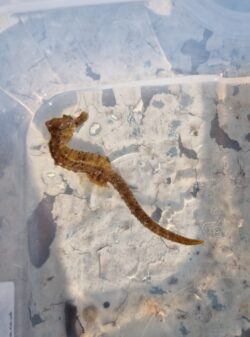During our fieldwork, Eco Marine staff regularly come across an array of interesting species. One species which is particularly exciting to find is the short snouted seahorse Hippocampus hippocampus. H. hippocampus are found in shallow muddy waters, such as in estuaries and seagrass beds. The species is relatively rare, making each encounter a special moment for our team. A few seahorses have been recorded in the Thames estuary in previous years by ZSL, Eco Marine has also recently observed some individuals in this area.
Two species of seahorse are present in the UK, H. hippocampus and the spiny seahorse Hippocampus guttulatus. H. hippocampus is identifiable due to, predictably, its shorter snout and lack of ‘mane’ which is observed in the spiny seahorse. Quite appropriately ‘hippocampus’ translates in English to ‘horse caterpillar’. Below is a juvenile H. hippocampus photographed by the Eco Marine field team.
In the UK, H. hippocampus is a Priority Species under the UK Post-2010 Biodiversity Framework, is protected under the Wildlife and Countryside Act 1981, and is a Feature of Conservation Importance for which Marine Conservation Zones can be designated. These protections have largely been put in place due to global overfishing and have made it illegal to kill, take, or disturb seahorses in British waters. Any records of seahorse individuals observed by Eco Marine are submitted to the Natural England Seahorse Specialist Team to aid in the monitoring of these species.
To find out more about what Eco Marine has been up to recently, click here.
